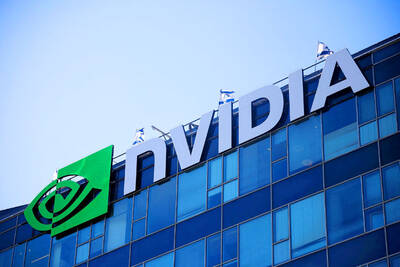The Nike streaker, clad only in scarf and shoes with the swoosh, starts across the soccer field when -- surprise -- out of nowhere comes a brawny football player with a red Reebok jersey who tackles the streaker and knocks him to the ground.
This commercial -- a parody of Nike's successful streaker commercial featuring Reebok's own "Terry Tate, Office Linebacker" character -- rates as a "gotcha" for Reebok, the one-time sneaker king that spent the 1990s watching Nike's dust.
Now Reebok says it is roaring back, led by Paul Fireman, the 58-year-old CEO who transformed the company from an obscure English custom shoe business to the biggest athletic shoe company in America by 1987 -- about the same time he was kicked upstairs and replaced by C. Joseph LaBonte, a Harvard business graduate and former head of the 20th-Century Film Corp.

PHOTO: NY TIMES
"There is a certain wish for vindication," Fireman, who never graduated from college, conceded in a recent interview.
Reebok, along with the other athletic shoe companies, still trail Nike: Sporting goods intelligence, a trade newsletter, estimated that, at the end of last year, Nike had 39.1 percent of the nation's athletic shoe business; Reebok had 12; New Balance had 11.6; and Adidas had 9.6 percent.
But analysts say Reebok has a good chance to at least double its share in the next few years. Since Fireman regained day-to-day control in November 1999, the Canton, Massachusetts, company has increased sales, increased cash and increased exposure.
In the fourth quarter of 2002, Reebok's total sales increased a better-than-expected 14.8 percent, to US$763 million. Clothing sales in the US grew 48.1 percent, to US$145 million. According to a Lehman Brothers report on Feb. 5, Reebok has had 11 consecutive quarters of sales increases.
"We are the No. 2 company in America," Fireman said. But ranking, he said, is not his priority.
"Right now, I'm not sure I want to surpass Nike's volume -- we did that once," Fireman said.
"As much as I want to be the No. 1 aspirational brand, we're on a good path now and if this escalates into a competition between Nike and ourselves and Adidas, then I'm happy with that, too."
Right now, Reebok is rushing to fill the empty shelves in the US' more than 2,500 Foot Lockers after Nike and Foot Locker, the world's largest athletic footwear chain, had a falling out.
In February 2002, Foot Locker told Nike the store wanted to reduce the number of Nike's marquee shoes, because it believed consumers were turning more to the mid-priced shoes.
According to a person close to the deal, Foot Locker told Nike it wanted to reduce its marquee shoes from 12 percent of the chain's business to 6 percent, and canceled US$150 million in Nike orders.
Nike struck back. Nike denied that it had pulled back on existing orders or punished Foot Locker with late shipments, as had been reported.
"But Foot Locker will no longer be a primary distribution for marquee and launch products," said Charles Denson, the president of Nike Brand, in a December call with analysts.
On Feb. 15, Nike's "Hall of Hoops" displays in the nation's Foot Locker stores were replaced by Reebok's "Above the Rim," featuring RBK shoes and jerseys and hats endorsed by Allen Iverson, the Philadelphia 76er star. Reebok has also filled the vacuum with more of its Classic line, part of the retro look that has been successful for such sneaker also-rans as Converse and Puma.
"They jumped on the retro trend, with sneakers like those sold 10 to 20 years ago -- the youth of today haven't seen them," said Matthew D. Serra, the chief executive of Foot Locker. "Retro is very hot, and Reeboks are very affordable: US$60, US$70 for most of them. We put them in, and the customers responded."
Because of the new business at Foot Locker, several analysts this week gave Reebok a good chance to increase its current 12 percent market share closer to 20 percent in the next few years.
"Obviously, the Nike-Foot Locker dispute opened the door," said John Horan, publisher of Sporting Goods Intelligence, an industry newsletter. "Both Reebok and Adidas are both going for 20 percent in the US."
Although he said he disdained rankings, Fireman has no problem with aspiring to 20 percent.
"I view this as a renaissance, a complete regrouping, a complete rebirth," Fireman said.
Fireman brought Reebok to America in 1979; in 1981, he took an English partner, Pentland Industry, run by Stephen Ruben, who got 56 percent of the common stock in exchange for US$77,500 in cash and US$300,000 in letters of credit, Fireman said.
Under his guidance, Reebok became an `980s phenomenon. In 1983, sales were US$12 million; by 1987, they were US$1.3 billion.
"It really exploded," he said. "In 1982, we introduced women's aerobic shoes -- we had running shoes up until then. In 1983, we reinvented the tennis shoe -- lightweight, cushioned, it didn't wear out." The company went public in 1985. When sales reached US$307 million, in 1991, the English partner was bought out.
Then the pendulum swung from fitness and individual sports to team sports. "Michael Jordan was famous by 1988, a basketball icon," Fireman said. "But Reebok had trouble making the transition into sports."
In 1987, the Reebok board decided it was time to let somebody else run the company and Fireman was elevated to the new position of chairman, with no responsibility for the day-to-day running of Reebok.
"All those young people, who would have climbed mountains for me, walked off a cliff for me," he said, trying not to sound bitter. "And all of us were replaced by people who were part of the package goods mentality."
Although sales continued to grow, Fireman contends the business ran out of gas, "all the emotions were gone."
Fireman came back as chief executive in November 1999, just as the stock price was approaching its nadir of around US$7. It closed at US$30.80 on Wednesday.
"The first year, we struggled to regain purpose," he said. "The second year, to retain integrity of the brand and the third year -- the question is how do we get into the game of winning, of moving to the top? We fixed the basics, built our self-esteem and built market share."
The company is now moving on multiple fronts: Besides Iverson, whom Reebok signed up six years ago, and a roster of younger basketball stars like Steve Francis of the Houston Rockets, the company has a deal with the rapper Jay-Z (although it balked at paying Kobe Bryant for an endorsement deal worth between US$4 and US$5 million). The marketing budget is now US$40 million, up 38 percent from the previous year.
In December 2000, Reebok signed a licensing contract with the NFL.
Nike still has merchandising deals with nine teams out of 26 NBA teams this year; by November 2004, it will have none. All the teams will be signed with Reebok.
But Reebok is still looking for a logo that rivals that of Nike.
"We've got this vector cross on every NFL jersey, a little square with a slant," Fireman said.
"We need our own swoosh. We need a recognizable symbol, something that gives the kid at the gym an emotional attachment."

Taiwan Semiconductor Manufacturing Co (TSMC, 台積電) last week recorded an increase in the number of shareholders to the highest in almost eight months, despite its share price falling 3.38 percent from the previous week, Taiwan Stock Exchange data released on Saturday showed. As of Friday, TSMC had 1.88 million shareholders, the most since the week of April 25 and an increase of 31,870 from the previous week, the data showed. The number of shareholders jumped despite a drop of NT$50 (US$1.59), or 3.38 percent, in TSMC’s share price from a week earlier to NT$1,430, as investors took profits from their earlier gains

In a high-security Shenzhen laboratory, Chinese scientists have built what Washington has spent years trying to prevent: a prototype of a machine capable of producing the cutting-edge semiconductor chips that power artificial intelligence (AI), smartphones and weapons central to Western military dominance, Reuters has learned. Completed early this year and undergoing testing, the prototype fills nearly an entire factory floor. It was built by a team of former engineers from Dutch semiconductor giant ASML who reverse-engineered the company’s extreme ultraviolet lithography (EUV) machines, according to two people with knowledge of the project. EUV machines sit at the heart of a technological Cold

AI TALENT: No financial details were released about the deal, in which top Groq executives, including its CEO, would join Nvidia to help advance the technology Nvidia Corp has agreed to a licensing deal with artificial intelligence (AI) start-up Groq, furthering its investments in companies connected to the AI boom and gaining the right to add a new type of technology to its products. The world’s largest publicly traded company has paid for the right to use Groq’s technology and is to integrate its chip design into future products. Some of the start-up’s executives are leaving to join Nvidia to help with that effort, the companies said. Groq would continue as an independent company with a new chief executive, it said on Wednesday in a post on its Web

CHINA RIVAL: The chips are positioned to compete with Nvidia’s Hopper and Blackwell products and would enable clusters connecting more than 100,000 chips Moore Threads Technology Co (摩爾線程) introduced a new generation of chips aimed at reducing artificial intelligence (AI) developers’ dependence on Nvidia Corp’s hardware, just weeks after pulling off one of the most successful Chinese initial public offerings (IPOs) in years. “These products will significantly enhance world-class computing speed and capabilities that all developers aspire to,” Moore Threads CEO Zhang Jianzhong (張建中), a former Nvidia executive, said on Saturday at a company event in Beijing. “We hope they can meet the needs of more developers in China so that you no longer need to wait for advanced foreign products.” Chinese chipmakers are in